Contents
3.7……… Business Process Analytics / Monitoring.
3.7.1…… Use Case Description.
3.7.2…… SFSF Job Monitor
3.7.3…… Solution Manager Job Monitoring.
3.7.4…… Business Process Analytics / Monitoring via SAP Solution Manager
3.8……… Work Mode and Downtime Management
3.8.1…… Use Case Description.
3.8.2…… Work Mode and Downtime Management via SAP HANA Cloud Integration.
3.8.3…… Work Mode and Downtime Management (Boomi Scenario)
3.8.4…… Work Mode and Downtime Management via SAP Solution Manager
3.9……… Maintenance and Release Management
3.9.1…… Use Case Description.
3.9.2…… BizX application Upgrade Center
3.9.3…… BizX application information
3.9.4…… Dell Boomi Release Control
3.9.5…… Dell Boomi Regression Testing.
3.10……. Change Management
3.10.1….. Use Case Description.
3.10.2….. Instance Sync.
3.10.3….. Change Management via Upgrade Center
3.10.4….. Maintain and change development content for Dell Boomi
3.11……. Test Management
3.12……. IT Service Management and Remote Access.
3.12.1….. Use Case Description.
4……….. Appendix.
3.7 Business Process Analytics / Monitoring
Business Process Monitoring is referencing to the guiding principle Business Process KPIs can be tracked for all components.
3.7.1 Use Case Description
Business Process Monitoring should provide a way to monitor business process KPIs cross different business process steps and technical components.
3.7.2 SFSF Job Monitor
How To
From Successfactors Admin Tools – Select Job Monitor
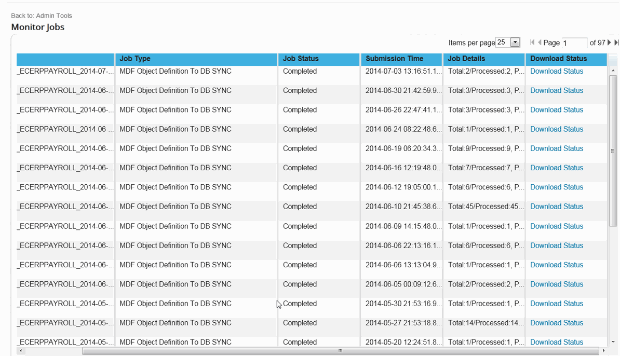
This monitor can e.g. be used to check the status of jobs and their submission time.
3.7.3 Solution Manager Job Monitoring
It is possible to use the Solution Manager Job monitoring tool to monitor the jobs used for the data consistency management. You can then detect failing jobs and get detailed information via the exception management tool.
In Job monitoring you can define a list of jobs you want to monitor and see their status:

Exception Management allows to find out the detailed exceptions which might have occurred.
3.7.4 Business Process Analytics / Monitoring via SAP Solution Manager
SAP Solution Manager provides with Business Process Monitoring (BP Mon) an integrated solution to collect and visualize business process KPIs cross different business process steps and technical components. Business process KPIs can be collected from SAP as well as non-SAP business systems. Different technical data retrieving methods as RFC, WS and direct data base access are supported. Once the appropriate data is retrieved, it will be unified and interpreted in the appropriate business context (modelled business processes with appropriate business process steps).
3.8 Work Mode and Downtime Management
The section Work Mode and Down Time Management is referencing to the guiding principle Maintenance windows and down times need to be communicated in advance. Work Mode and Down Time Management needs to ensure synchronization of maintenance times for OP/Private Cloud and Public Cloud components.
3.8.1 Use Case Description
Customers may want to check the status of any systems involved in their business processes.
3.8.2 Work Mode and Downtime Management via SAP HANA Cloud Integration
The section Work Mode and Down Time Management is referencing to the guiding principle Maintenance windows and down times need to be communicated in advance. Work Mode and Down Time Management needs to ensure synchronization of maintenance times for OP/Private Cloud and Public Cloud components.
3.8.2.1 Uptime Report
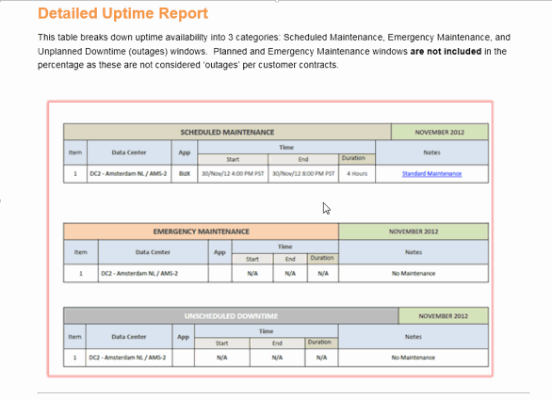
3.8.2.2 Scheduled Maintenance
A scheduled maintenance window is defined as a period in which SuccessFactors’ service may be down for maintenance. More information about contractual maintenance windows, which are regular times SuccessFactors may utilize for scheduled maintenance.
You can view upcoming scheduled maintenance by visiting the Service Status tab in the Cloud Support Portal and clicking the Scheduled Maintenance link.
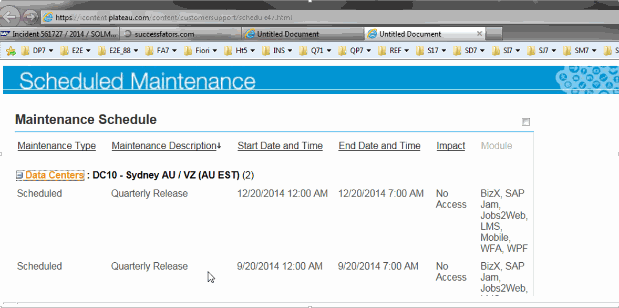
How To : Open URL https://support.successfactors.com/
> Cloud Support Portal > Service Status > Scheduled Maintenance
3.8.3 Work Mode and Downtime Management (Boomi Scenario)
How To Access Dell BOOMI website
Dell Boomi > Your Account > Setup > System Message
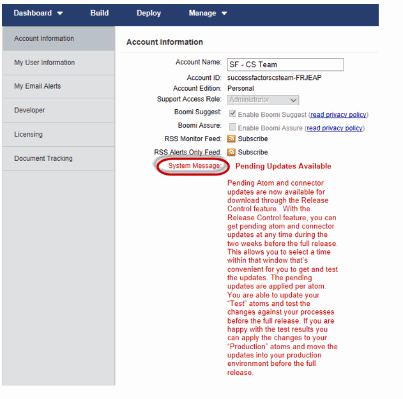
Dell Boomi plan regular maintenance windows.
This has to be kept in mind for customer operation.
3.8.4 Work Mode and Downtime Management via SAP Solution Manager
How To
Solution Manager > Technical Administration > Work Mode Management
Prerequisites and additional information
Allows to view the planned maintenance and suspend the corresponding Alerts and setup Notification.

3.9 Maintenance and Release Management
The section maintenance and release management is referencing to the guiding principle synchronized software and configuration maintenance needs to be ensured
3.9.1 Use Case Description
In public cloud applications the release and maintenance management is owned by the cloud provider. Any corrections or software updates in the public cloud software are defined and deployed by the cloud provider. Customers cannot withdraw from maintenance activities conducted by the cloud provider. However, in return the cloud provider has to ensure maximum business continuity for the customers.
3.9.2 BizX application Upgrade Center
The Upgrade Center in BizX application provides the summary of Upgrades activated within Upgrade Center. You can get a snapshot of past upgrades performed via the Upgrade Center, get additional information about the feature, know who did the upgrade, and even undo the change.
How To
> BizX application > Administration Tools > Upgrade Center
3.9.3 BizX application information
From within the BizX application, navigate to the bottom of any page and click the hyperlink ‘Show version information.’
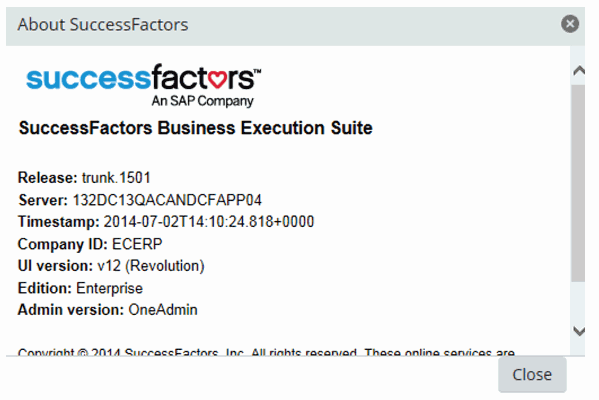
How To
BizX application > Show version information (at the bottom of any page)
3.9.4 Dell Boomi Release Control
The Atom/Connector Versions tab on the Atom Management page displays your Atom and connectors, including Dell Boomi connectors and connectors developed by Dell Boomi partners. This tab is used to get pending updates and to roll back updates. See the Atom/Connector Versions Tab topic linked below for more details.
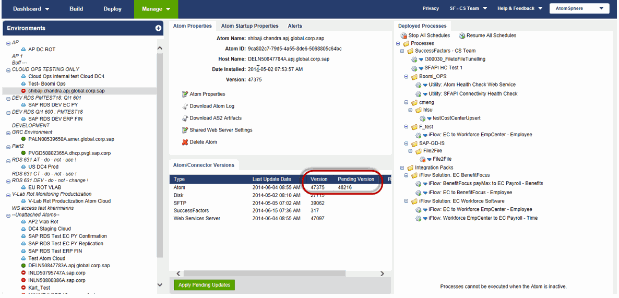
How To
> Dell Boomi > Manage > Atom Management > Atom/Connector Versions
How To
Check trust.boomi.com for information on planned / unplanned downtimes
3.9.5 Dell Boomi Regression Testing
Dell Boomi releases new versions of its integration platform on a regular basis. The same holds true for all kind of backend systems which Dell Boomi connects to. In such cases, it is important to ensure that customer integration content being deployed on Dell Boomi will work also after such software updates.
In case of SAP standard integration packages, SAP tests compatibility of these releases under various conditions. Moreover, corrections to these integration packages are delivered on a regular basis. In this way, SAP ensures compatibility of its integration content with new releases of Dell Boomi or backend systems.
The situation is different for integration content which was developed by the customer himself, who is then responsible for the maintenance of this content himself. In order to ensure compatibility of integration content with new releases of DellBoomi, Dell allows customers to submit their integration processes to Dell Boomi for regression testing by Dell. This feature is called Boomi Assure. For details, go to help.boomi.com and search for “Boomi Assure”, or directly open http://help.boomi.com/atomsphere/GUID-5AF4D3AC-AB97-47A6-984F-ED5D65E76CF2.html.
3.10 Change Management
The section Change Management is referencing to the guiding principle synchronized software and configuration maintenance needs to be ensured and no change is executed unsynchronized
3.10.1 Use Case Description
The purpose of the Change Management is to ensure that standardized methods and procedures are used for efficient and prompt handling of all changes associated with customer specific configuration / settings and development. The target is to minimize the number and impact of any related incidents and to support consistent, transparent, and auditable change management processes across the complete system landscape supporting the customer’s business. The trigger of such changes could be the need to respond to problems (reactive approach) or reflection of business initiatives, programs, projects, or service improvements (proactive approach)
3.10.2 Instance Sync
The Instance sync tools allows to move configuration settings from one SuccessFactors instance to another instance
How to:
Opt-in feature in the Admin Tools area
Prerequisites and additional information
User needs permission granted via the administrative privileges for source instance
Eligible source and target instances need to be defined upfront
Following objects can be transferred:
- PM Templates
- Goal Templates
- Families & Roles
- Competency Libraries
- Picklists
- Route Maps
- Rating Scales
- Form Label Translations
- RBP Roles
- RBP Groups
- Dashboard Settings
- System Properties Settings
- MDF Picklists
- MDF Object Definitions
- MDF Configuration UI
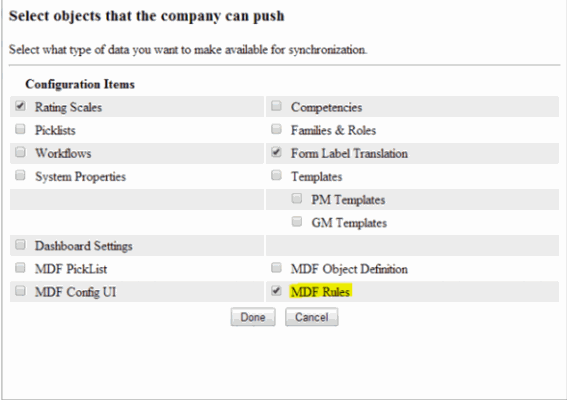
3.10.3 Change Management via Upgrade Center
How To
From the Admin tool click on Upgrade Center
Prerequisites and additional information
User needs required admin authorizations.
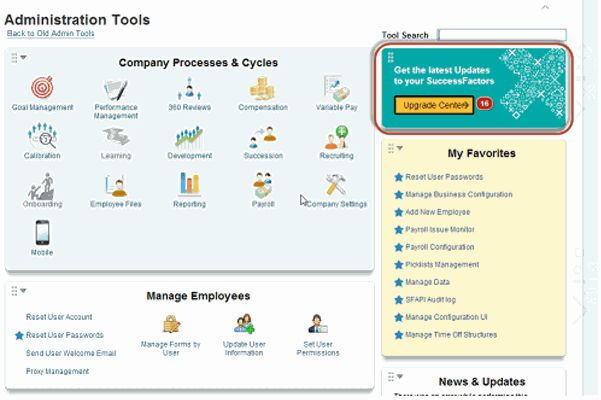
Upgrade Center displays upgrades that are recommended for your system and provides additional information including a detailed description of the innovation, system prerequisites and gives you the ability to perform the upgrade in a single click.
3.10.4 Maintain and change development content for Dell Boomi
Development content for Dell Boomi is maintained in Dell’s platform.boomi.com which is hosted by Dell. In order to provide guidelines for development and changes of content on this platform, SAP has provided development standards in the guide
http://help.sap.com/hr_api –> Boomi Development Standards Guide
Among other things, it discusses:
- Boomi Project Best Practices
- Boomi Project LifeCycle Management
- Development best practices
3.11 Test Management
3.12 IT Service Management and Remote Access
The section IT Service Management and Remote Access is referencing to the guiding principle Safe and reliable remote access
3.12.1 Use Case Description
The target is to provide one tool for the end users and key users in which all incidents are processed, independently from where or for which application the incident has been opened. It is not wanted that end or key users have to use different incident management tools for each application that is consumed by them. It should be possible to create incidents directly from within any application and automatic dispatching of incidents based on the context of the message (e.g. a message created in a HR application should be opened from with the application and automatically be dispatched to the appropriate key user)
4 Appendix
Customer support
All SAP Support offerings are unified within the SAP Support portal
https://support.sap.com
In this central site, SAP offers various kind of support information which cover SuccessFactors as well as other SAP products within a combined approach. This includes: SAP customer incident processing, SAP Premium and Enterprise Support services and various other topics. Expert advice for operating your SuccessFactors landscape is also given within regular Meet the Expert sessions which are available under
https://support.sap.com/support-programs-services/programs/enterprise-support/academy.html
à Meet the Expert (MTE)
For support offerings specific to SuccessFactors products, visit
https://support.successfactors.com/in order to address your SuccessFactors support request via various communication channels available within this central site.
Guideline principle
- Principle: Single source of truth
It needs to be ensured that the complete solution landscape containing can be documented. This includes the technical landscape, as well as the business processes and their context information as interfaces and test cases.
- Principle: Full transparency regarding performance and availability
End users of customers needs to track availability of certain scenarios and measure their performance. Customers like to understand the end-user behavior measured from their end user’s locations.
- Principle: Reliable data transfer and message transport
Typically, master data as well as transactional data need to be exchanged on a regular basis between Public Cloud and OP/Private Cloud components. It needs to be ensured that data and message transfer is executed in a reliable matter. This means no data or message can get lost and in case the data or message transfer is disturbed, the situation is monitored and alerted.
- Principle: Every business critical exception is caught and reported
Especially for business processes, it is absolutely necessary to ensure that every business-critical exception is recognized by the customer’s business operations team.
- Principle: No data inconsistencies
Master and transactional data are exchanged as a one-time event or on a regular basis. These data exchange processes can be successfully completed or fail. Failed data exchange processes should be identified.
- Principle: Business Process KPIs can be tracked for all components
It needs to be ensured that business process KPIs can be provided and visualized. Business Process KPIs indicate clearly whether business processes are running smoothly.
- Principle: Maintenance windows and down times need to be communicated in advance
To run business processes smoothly, components need to be available or the non-availability of the component needs to be handled sufficiently, e.g. by stopping interfaces and queuing of the relevant message. Accordingly customers need to have transparency in case of maintenance.
- Principle: Synchronized software and configuration maintenance needs to be ensured
Software and configuration dependencies must be clearly documented. Release plans need to be communicated in advance. Overall stable and reliable operation of end-to-end business processes needs to be ensured.
- Principle: No change is executed unsynchronized
This means technical interfaces exist between Public Cloud and OP/Private Cloud components. Accordingly the reliable operation of hybrid solutions is depending on the fact that changes of configuration and software are executed in a synchronized way.
- Principle: All software and configuration changes are tested end-to-end
To avoid disruption in the productive usage of software it needs to be ensured sufficient testing is possible. Manual and automated tests shall be executed on the relevant part of the solution.









